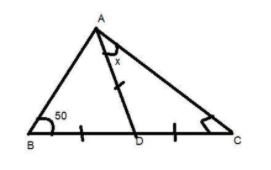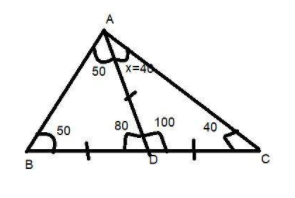
In the given figure, find the value of x.
${\text{A}}{\text{. }}{40^0}$
${\text{B}}{\text{. }}{50^0}$
${\text{C}}{\text{. }}{60^0}$
${\text{D}}{\text{. }}{25^0}$


Answer
606.3k+ views
Hint: Here we go through the properties of the isosceles triangle and the properties of the sum of all internal angles of a triangle which is ${180^0}$ to find the unknown angle.
Given that ABC is a triangle in which D is the midpoint of side BC.
So we can say that BD=DC.
It is also given that the length AD is equal to the length BD and DC.
$\therefore {\text{AD = BD = DC}}$
Now in $\vartriangle {\text{ABD}}$
${\text{AD = BD}}$ (Given in the question)
It means that $\vartriangle {\text{ABD}}$ is an isosceles triangle.
So the base angle of side BD and AD are equal which means $\angle {\text{DBA = }}\angle {\text{DAB = 5}}{{\text{0}}^0}$ given in the figure.
And we know that the sum of all interior angles of a triangle is ${180^0}$.
$
\therefore \angle {\text{DBA + }}\angle {\text{DAB + }}\angle {\text{BDA}} = {180^0} \\
\Rightarrow {50^0} + {50^0} + \angle {\text{BDA}} = {180^0} \\
\Rightarrow \angle {\text{BDA}} = {180^0} - {100^0} \\
\therefore \angle {\text{BDA}} = {80^0} \\
$
And now BDC is a straight line
$\therefore \angle {\text{BDA}} + \angle {\text{ADC = 18}}{{\text{0}}^0}$ Straight angle.
$ \Rightarrow \angle {\text{ADC = 18}}{{\text{0}}^0} - {80^0} = {100^0}$ $\because \angle {\text{BDA}} = {80^0}$
And now in $\vartriangle {\text{ABC}}$
${\text{AD = CD}}$ (Given in question).
It means that $\vartriangle {\text{ADC}}$ is an isosceles triangle.
So the base angle of side BD and AD are equal which means $\angle {\text{DCA = }}\angle {\text{DAC = }}x$ given in the figure.
And we know that the sum of all interior angles of a triangle is ${180^0}$.
$
\therefore \angle {\text{DCA + }}\angle {\text{DAC + }}\angle {\text{ADC}} = {180^0} \\
\Rightarrow x + x + {100^0} = {180^0} \\
\Rightarrow 2x = {180^0} - {100^0} \\
\therefore x = {40^0} \\
$
Hence, option A is the correct answer.

Note: Whenever we face such a type of question the key concept for solving the question is that you have to first read the diagram what it says and the data which are given in the diagrams. Then by applying the properties of triangles start finding the unknown terms to get the answer.
Given that ABC is a triangle in which D is the midpoint of side BC.
So we can say that BD=DC.
It is also given that the length AD is equal to the length BD and DC.
$\therefore {\text{AD = BD = DC}}$
Now in $\vartriangle {\text{ABD}}$
${\text{AD = BD}}$ (Given in the question)
It means that $\vartriangle {\text{ABD}}$ is an isosceles triangle.
So the base angle of side BD and AD are equal which means $\angle {\text{DBA = }}\angle {\text{DAB = 5}}{{\text{0}}^0}$ given in the figure.
And we know that the sum of all interior angles of a triangle is ${180^0}$.
$
\therefore \angle {\text{DBA + }}\angle {\text{DAB + }}\angle {\text{BDA}} = {180^0} \\
\Rightarrow {50^0} + {50^0} + \angle {\text{BDA}} = {180^0} \\
\Rightarrow \angle {\text{BDA}} = {180^0} - {100^0} \\
\therefore \angle {\text{BDA}} = {80^0} \\
$
And now BDC is a straight line
$\therefore \angle {\text{BDA}} + \angle {\text{ADC = 18}}{{\text{0}}^0}$ Straight angle.
$ \Rightarrow \angle {\text{ADC = 18}}{{\text{0}}^0} - {80^0} = {100^0}$ $\because \angle {\text{BDA}} = {80^0}$
And now in $\vartriangle {\text{ABC}}$
${\text{AD = CD}}$ (Given in question).
It means that $\vartriangle {\text{ADC}}$ is an isosceles triangle.
So the base angle of side BD and AD are equal which means $\angle {\text{DCA = }}\angle {\text{DAC = }}x$ given in the figure.
And we know that the sum of all interior angles of a triangle is ${180^0}$.
$
\therefore \angle {\text{DCA + }}\angle {\text{DAC + }}\angle {\text{ADC}} = {180^0} \\
\Rightarrow x + x + {100^0} = {180^0} \\
\Rightarrow 2x = {180^0} - {100^0} \\
\therefore x = {40^0} \\
$
Hence, option A is the correct answer.

Note: Whenever we face such a type of question the key concept for solving the question is that you have to first read the diagram what it says and the data which are given in the diagrams. Then by applying the properties of triangles start finding the unknown terms to get the answer.
Recently Updated Pages
Master Class 9 General Knowledge: Engaging Questions & Answers for Success

Master Class 9 English: Engaging Questions & Answers for Success

Master Class 9 Science: Engaging Questions & Answers for Success

Class 9 Question and Answer - Your Ultimate Solutions Guide

Master Class 8 Maths: Engaging Questions & Answers for Success

Class 8 Question and Answer - Your Ultimate Solutions Guide

Trending doubts
Which places in India experience sunrise first and class 9 social science CBSE

Fill the blanks with the suitable prepositions 1 The class 9 english CBSE

Write the 6 fundamental rights of India and explain in detail

Difference Between Plant Cell and Animal Cell

What is pollution? How many types of pollution? Define it

What is the Full Form of ISI and RAW





